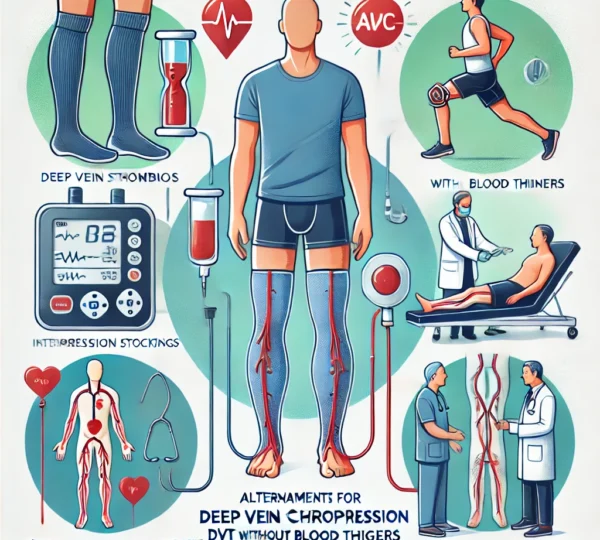Can’t Take Blood Thinners for DVT? Here Are Your Alternatives
Introduction to DVT Treatment Alternatives
Deep vein thrombosis (DVT) is a condition where a blood clot forms in a deep vein, often in the legs. While blood thinners are commonly prescribed to prevent the growth of clots, not everyone can take them. Some people may have medical conditions that increase their bleeding risk, or they may be allergic to the medication. If you can’t take blood thinners, it’s important to understand that there are alternative treatment options that can help manage DVT and reduce the risk of complications.
What if You Can’t Take Blood Thinners?
If you can’t use blood thinners, there are other treatment options available. Here are some alternatives:
1. Compression Stockings
Compression stockings are designed to apply gentle pressure to the legs, which helps to maintain blood circulation. By improving blood flow in the veins, compression stockings can significantly reduce the risk of clot formation. They are especially helpful for those who spend a lot of time sitting or standing, as they can help prevent blood from pooling in the lower legs. Your doctor may recommend wearing them daily to help manage DVT or to prevent its recurrence.
How Compression Stockings Work:
- They compress the veins in the legs, pushing blood upward and preventing stagnation.
- They are available in different compression levels, depending on the severity of your condition.
- Regular use can help prevent swelling and reduce discomfort caused by DVT.
2. Regular Exercise
Exercise is another important factor in managing DVT. Physical activity encourages blood circulation throughout the body and helps prevent the formation of blood clots. When the muscles in your legs are engaged, they help pump blood back to the heart, reducing the chances of clotting.
Types of Exercises to Consider:
- Walking: A low-impact activity that’s easy to incorporate into daily life. A 30-minute walk each day can improve circulation.
- Leg Lifts and Ankle Rotations: Simple exercises you can do while seated to engage the lower leg muscles.
- Swimming: A full-body workout that minimizes strain on the joints while promoting circulation.
Always consult with your healthcare provider before starting an exercise program, as some activities may be too intense depending on your specific condition.
3. Intermittent Pneumatic Compression (IPC)
Intermittent pneumatic compression (IPC) therapy uses inflatable cuffs wrapped around the legs to promote blood flow. These cuffs inflate and deflate in intervals, squeezing the legs to move blood through the veins, mimicking the natural muscle contractions that occur during physical activity. IPC therapy is typically used in a medical setting, though portable devices are available for home use.
How IPC Helps with DVT:
- It reduces swelling and improves venous return (blood flow back to the heart).
- It can prevent clots from growing or forming in the first place, especially after surgery or long periods of immobility.
- It is a helpful alternative for those who cannot take blood thinners or who experience complications with medication.
4. Surgery for Blood Clots
In some cases, surgery may be necessary to remove a blood clot that has formed in a deep vein. Surgery is generally considered when other treatment methods, like blood thinners or IPC therapy, aren’t effective, or if the clot poses a significant risk of moving to the lungs (a condition called pulmonary embolism). Surgical options include clot removal (thrombectomy) or the placement of a filter in the vein to catch clots before they travel to the lungs.
Types of Surgical Procedures:
- Thrombectomy: The removal of a blood clot through a surgical procedure.
- Inferior Vena Cava (IVC) Filter: A filter placed in the large vein to capture clots before they reach the lungs.
- Endovenous Laser Therapy (EVLT): A minimally invasive procedure that uses laser energy to treat varicose veins and prevent DVT.
Surgery is generally only recommended when the risk of complications is high, and other non-invasive methods have been unsuccessful.
5. Lifestyle Changes
In addition to medical treatments, making certain lifestyle changes can further reduce the risk of DVT or help manage the condition. For instance, staying hydrated, avoiding sitting or standing for long periods, and maintaining a healthy weight can all contribute to better blood circulation and a reduced risk of clot formation.
Healthy Lifestyle Tips for Managing DVT:
- Stay Active: Avoid long periods of immobility. If you have a desk job, try to stand or walk for a few minutes every hour.
- Manage Weight: Maintaining a healthy weight helps reduce strain on the veins and improves circulation.
- Avoid Smoking: Smoking increases the risk of blood clots by damaging blood vessels.
6. Anticoagulants and Other Medications
While some people cannot take traditional blood thinners, there are other medications that may be safer or more suitable depending on the individual. For example, newer anticoagulants may be prescribed that have fewer side effects or require less frequent monitoring.
Alternative Medications:
- Direct Oral Anticoagulants (DOACs): These medications, like rivaroxaban and apixaban, work similarly to traditional blood thinners but require less monitoring and have fewer interactions with other medications.
- Low Molecular Weight Heparin (LMWH): An injectable medication that may be recommended for patients who can’t take oral blood thinners.
Always work with your healthcare provider to find the most appropriate treatment for your specific needs.
Conclusion
If you have DVT and cannot take blood thinners, there are several treatment options available. Compression stockings, regular exercise, intermittent pneumatic compression, surgery, and lifestyle changes can all contribute to managing the condition. It’s important to work closely with your doctor to determine the best course of action for your health and well-being.
By exploring these alternatives, you can actively manage your condition, reduce the risk of complications, and improve your quality of life.
For more information Click Here



